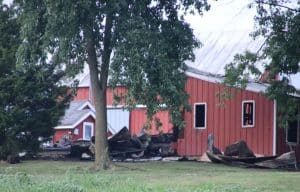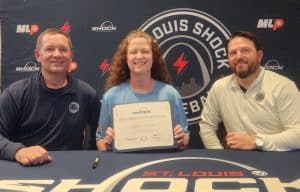Waterloo native returns from second tour in Afghanistan
Waterloo native and U.S. Army Corps of Engineers employee John Osterhage returned last week from a second tour of duty in Afghanistan. Osterhage has combined for two deployments there now for a total of about 11 months in the last two years.
A civil engineer, he told the Republic-Times of his experiences supervising building infrastructure for the Afghan National Defense organizations – their army and national police.
“We supervised construction of bases for the military, including buildings, roads and utilities, and police stations and barracks for the police,” he said.
A graduate of the University of Missouri at Rolla, Osterhage has worked for the Army Corps in St. Louis since January 2009.
In St. Louis, he works in the Civil Design Section, primarily focused on water control structures such as locks and dams and levees.
One of the opportunities Osterhage cited from his tours in Afghanistan was the chance to be involved with what he termed “vertical construction,” supervising contractors building buildings, as opposed to the ground structures he is focused on in St. Louis.
“My work involved actual construction, versus being focused on design,” he said.
Asked what he found most interesting in Afghanistan, he said, “I enjoyed going ‘outside the wire’” – leaving the confines of protected work and living areas. On both tours, the chance to get out into the countryside while en route to job locations, seeing how the people there live, was remarkable, he said.
He also enjoyed meeting and working with fellow Corps of Engineers employees from across the country and around the world.
“It changes your perspective on life, to be sure,” he said. “When I travel through areas back here that are seen as deprived or poverty-stricken, I think how most Afghans would find them quite luxurious – having electricity, running water and indoor plumbing, and air conditioning.”
Osterhage dismissed the notion that Afghanistan is a desert country like we commonly think of as the Middle East.
“I was in Kabul, the Afghan capital,” he said. “That’s in a 6,000-foot elevation mountain range. They don’t have what we would call sand. Rather, it is a fine, talcum powder-like dust. The climate is much like St. Louis, temperature-wise, but a lot dryer,” he said. “We had snow on my last tour there.”
Asked how Afghans view Americans, he said in Kabul, where education levels are higher, and especially within the cadre of employees working for the Corps and contractors, Americans are seen as a mostly positive presence.
“Farther out in the hinterland, we are less known and probably less appreciated,” he thought. “You have to remember, we have been there 13 years now, so some may be tiring of our presence. In recent decades, they’ve had a Russian occupation and other outside influences. They have been a crossroad for invaders for centuries.”
Osterhage shared a statistical report citing progress in trying to lift the Afghan nation and people out of poverty.
In 2001, when U.S. forces intervened to combat the Taliban, there were about 12,000 miles of roads. Today there are 25,000 miles. There were 25,000 cell phone users where there are now some 18 million. Schools have increased from 1,000 to 14,000, and the literacy rate has soared from 12 to 32 percent.
There was no commercial overflight or landings then, and today there are more than 750 daily. Life expectancy has climbed from 43 to 60.5 years, and the number of healthcare facilities has expanded by five times from 498 to 2,507.
Osterhage also corrected a misnomer — calling Afghanistan part of the Middle East.
“It is more of a Southeast Asian culture, with Arab influences to be sure, and shares a great deal with India and Pakistan,” he said.
Osterhage is not an “accumulator,” and has brought little except experiences and memories back from his tours in Afghanistan.
“There’s a rug on the living room floor, and a couple of brass vessels on the mantle, and that blue stone bowl over there,” he said, pointing to a table. “That stone comes from the country’s northern reaches, and is often seen in jewelry.”
What was the hardest part of his deployment?
Osterhage said he felt safe there, with armed security being provided contractors and later, military security units.
“I guess the hardest part was being away from home, friends and family,” he said. “My first deployment, like this one, started in August. But I was away at Christmas and New Years. I didn’t return until February that time.”
Osterhage added, though, that he enjoyed good communication with home on both tours.
“We had good internet, skyping and calling was just like picking up the phone at home,” he said.
John, a 2005 graduate of Gibault Catholic High School, and son of Roger and Rose Osterhage of Waterloo, said he will return to work in St. Louis in early January.
“Until then, I am going to enjoy family and friends, and just relax.”






